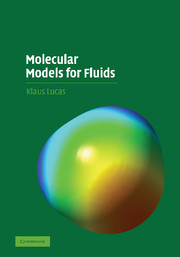Book contents
- Frontmatter
- Contents
- Nomenclature
- Preface
- 1 Introduction
- 2 Foundations
- 3 The Ideal Gas
- 4 Excess Function Models
- 5 Equation of State Models
- Appendix 1 Fundamental Constants and Atomic Units
- Appendix 2 Stirling's Formula
- Appendix 3 Relative Probability of a Microstate
- Appendix 4 Spherical Harmonics, Rotation Matrices, and Clebsch–Gordan Coefficients
- Appendix 5 Higher-Order Perturbation Terms for the Intermolecular Potential Energy of Simple Molecules
- Appendix 6 Rules for Integration
- Appendix 7 Internal Rotation Contributions
- Appendix 8 Quasichemical Approximation for the Degeneracy in a Lattice
- Appendix 9 Off-Lattice Formulation of the Quasichemical Approximation
- Appendix 10 Combinatorial Contribution to the Excess Entropy in a Lattice
- Appendix 11 Integration Variables for Three-Body Interactions
- Appendix 12 Multipole Perturbation Terms for the High-Temperature Expansion
- Index
Appendix 3 - Relative Probability of a Microstate
Published online by Cambridge University Press: 11 March 2010
- Frontmatter
- Contents
- Nomenclature
- Preface
- 1 Introduction
- 2 Foundations
- 3 The Ideal Gas
- 4 Excess Function Models
- 5 Equation of State Models
- Appendix 1 Fundamental Constants and Atomic Units
- Appendix 2 Stirling's Formula
- Appendix 3 Relative Probability of a Microstate
- Appendix 4 Spherical Harmonics, Rotation Matrices, and Clebsch–Gordan Coefficients
- Appendix 5 Higher-Order Perturbation Terms for the Intermolecular Potential Energy of Simple Molecules
- Appendix 6 Rules for Integration
- Appendix 7 Internal Rotation Contributions
- Appendix 8 Quasichemical Approximation for the Degeneracy in a Lattice
- Appendix 9 Off-Lattice Formulation of the Quasichemical Approximation
- Appendix 10 Combinatorial Contribution to the Excess Entropy in a Lattice
- Appendix 11 Integration Variables for Three-Body Interactions
- Appendix 12 Multipole Perturbation Terms for the High-Temperature Expansion
- Index
Summary
To derive an expression for the relative probability Pi of a microstate i we first consider a canonical ensemble, i.e., a collection of systems, each with fixed values of N, V, and T; cf. Figure A 3.1. The ensemble as a whole is isolated adiabatically so that the total energy of the canonical ensemble has a fixed value, Uc. Each of the πc systems of the canonical ensemble finds itself in a large heat bath at temperature T provided by the other systems.
Many different microstates or quantum states are associated with each fixed macrostate of the canonical ensemble. Different quantum states of a canonical ensemble may be represented by different distributions of its systems over the many possible energy states of the single system.We denote by {Ei} the various possible energy values of a system in the canonical ensemble. In principle, the spectrum of energy values of the system follows from its Schrödinger equation. We assume in the following that the spectrum of energy values is known. It is identical for each system of the canonical ensemble, because the values of V and {Nα} are identical. Thus {Ei} is available as a set of values (E1, E2, E3, …, Ej), if we assume a total of j quantum states for each system. At each moment of time each system of the canonical ensemble will be found in one of these energy states, whose number j is extremely large.
- Type
- Chapter
- Information
- Molecular Models for Fluids , pp. 343 - 350Publisher: Cambridge University PressPrint publication year: 2007



